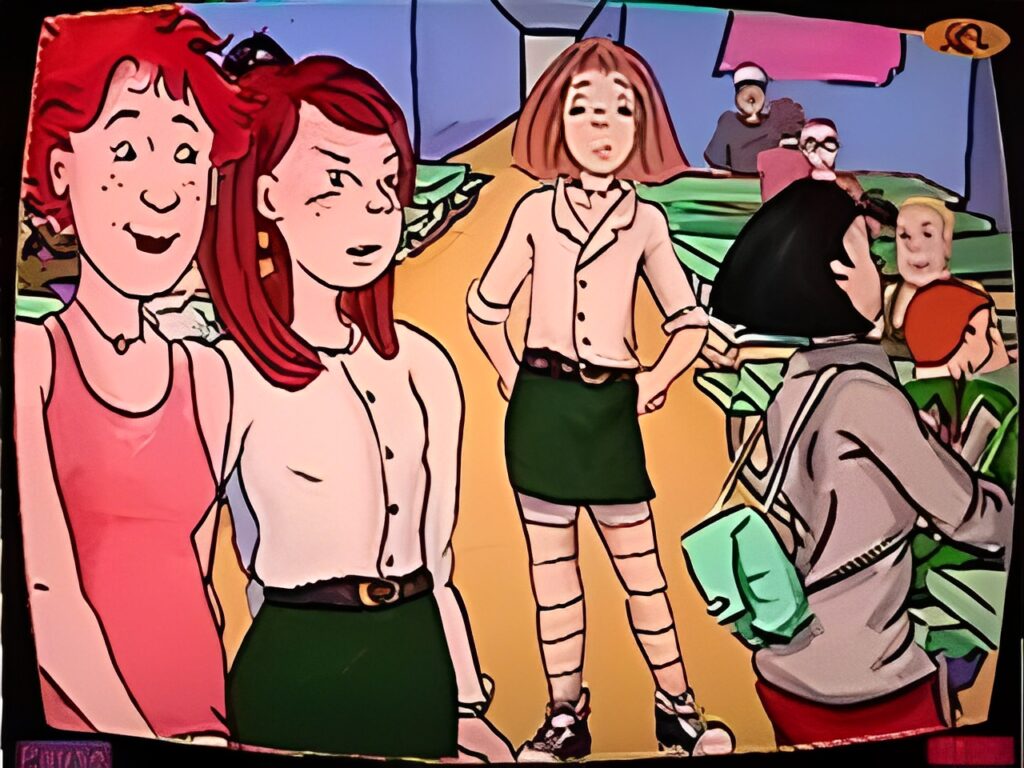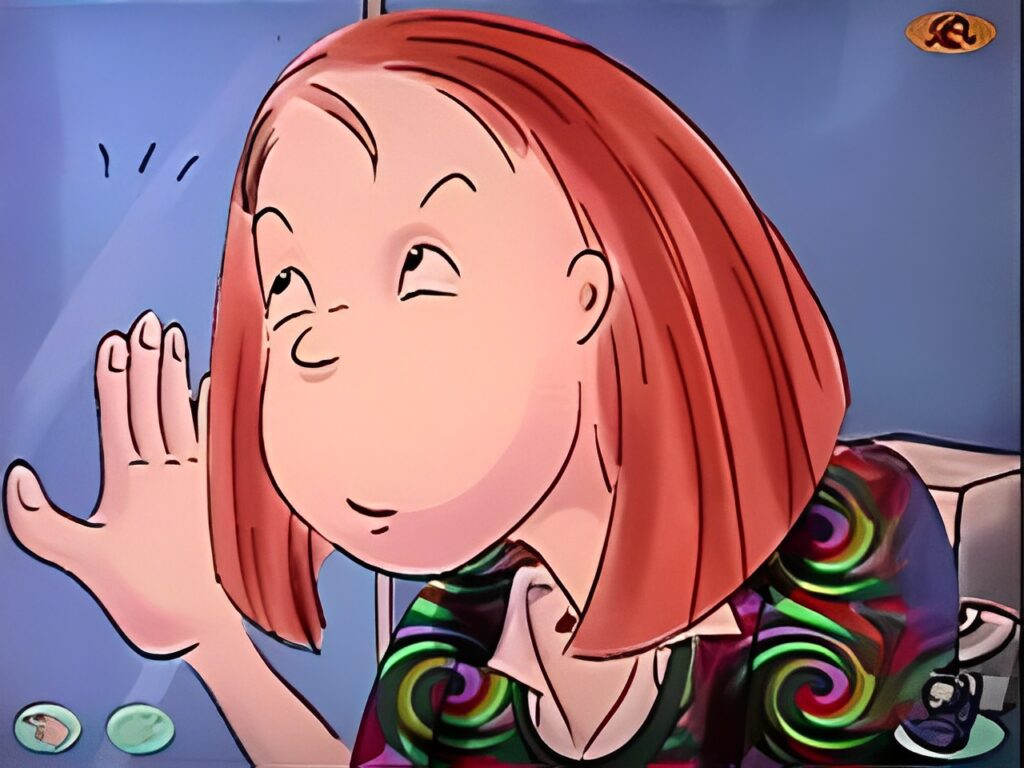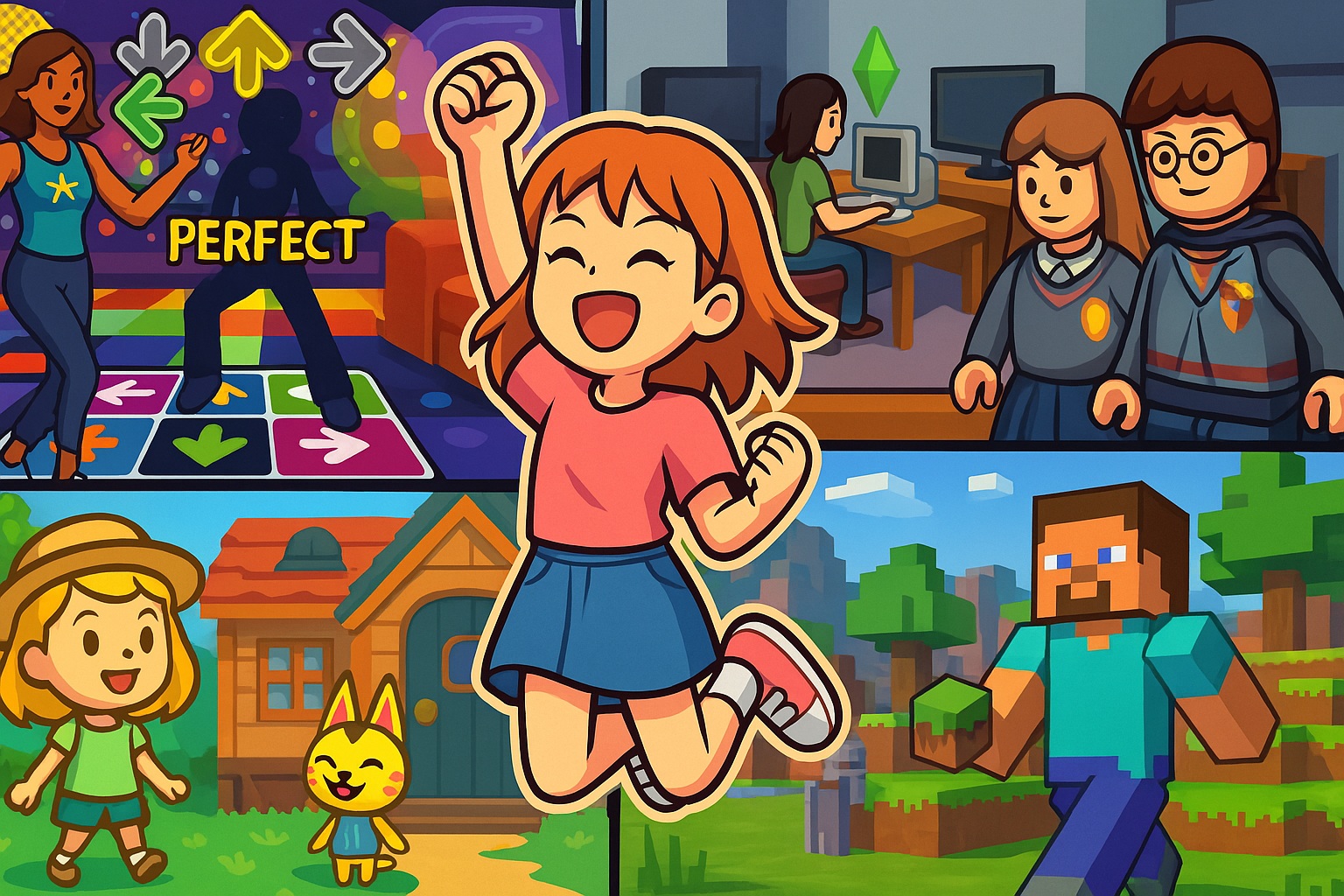This page may contain one or more affiliate links, which means that if you purchase a product through that link, I may receive compensation. The links will be identified with the text "affiliate link". Click to learn more.
Girl games have come a long way since the days of pink boxes and dress-up clicks. From early games for girls like Barbie Fashion Designer to modern kids games that blend storytelling, puzzles, and emotional nuance, the genre has evolved, but not always in ways people expected. This article explores how creative games designed for preadolescent girls first emerged, what they promised, and whether today’s titles still reflect those original goals. Along the way, we’ll revisit classics like Rockett’s New School and The Barbie Diaries, and look at what younger girls are actually playing now.
This isn’t a brand-new subject. It was first brought into focus by the surprise success of Barbie Fashion Designer and the publication of From Barbie to Mortal Kombat. That book explored the limited market of kids games created specifically for preadolescent girls and argued for their importance in introducing girls to computer technology. In a nutshell, its findings suggested that girls gravitate toward social relationships, creativity, humor, mysteries, and puzzles. They may take losing personally, prefer real-world settings over sci-fi, and enjoy cooperative play.
Years have passed since the book’s release, and it appears developers took notice. I remember walking down the software aisle in a department store some time ago and seeing shelves filled with mystery games, a Nancy Drew series, and titles about veterinary care, horse care, and other themes clearly aimed at preadolescent girls. Around the same time, similar titles were being released for consoles like the Nintendo DS and Wii, which dominated the market in the 2000s. [A follow-up book to From Barbie to Mortal Kombat exists, though I haven’t read it and won’t reference it here.]
Has the Gap Closed?
My guess is that newer generations are now born into technology, and that shift feels seamless. But what role did those girl-targeted games actually play? I’ve recently seen girls playing Dance Dance Revolution, racing games, and even violent titles like Gears of War. DDR seems consistent with earlier findings, but those other games—fast-paced and action-heavy—seem to contradict what the book originally described. So what’s happening?
It seems the gap between boys and girls is narrowing, and that evolution is reflected in the types of games people play. First, women began wearing pants. Then they entered the workforce. Now they play sports competitively—and yes, they play video games with just as much intensity. What I mean is this: even though the market now contains a wider range of titles, I’m not convinced girls found games that aligned with their preferences. It might be that they adapted to the available content instead.
So, do we embrace this shift and accept that girls will grow up to play combat-heavy games and trade bubblegum for bravado, or do we acknowledge their emotional instincts and preserve space for content that reflects that? That may sound like a loaded question, but the intention is sincere. Let’s take a closer look at a couple of games that were designed specifically with girls in mind.
Rockett’s New School

For those unfamiliar, the Rockett series was the brainchild of Brenda Laurel and produced by Purple Moon, a now-defunct company created specifically to address girls’ needs in gaming. Although the series wasn’t always warmly received, I have a lot of respect for what Laurel attempted.
Rockett’s New School plays like a “choose your own adventure” story. Players follow Rockett through her first days at a new school, making choices that shape how the story unfolds. Unlike other games in this format, it features full voice acting, very little clicking, and almost no reading. The narrative is delivered through illustrated scenes with modest animation. Players can even snoop inside other students’ lockers—an odd but entertaining addition.
I’ll admit—I found the game surprisingly enjoyable. Design-wise, it’s imperfect; some sections are confusing. But it has charm. Rockett herself is likable and thoughtfully presented. She wears a skirt (suggesting femininity) with stockings (adding balance to the design). The scenarios she faces feel realistic—like overhearing someone gossiping about you from a bathroom stall. Decisions never punish the player emotionally, which is refreshing given how intense school-life can be.
There were criticisms about stereotypes, but storytelling often uses character archetypes to avoid confusion: the hero is likable, the villain looks suspicious, and so on. In my experience, the stereotyping here felt minimal.
What Does Rockett Offer?

Now, what does the game offer? First, it’s based in a realistic setting. Second, it includes exploratory elements—though they’re inconsistent. Third, Rockett navigates friendship dynamics. Fourth, there’s no real way to “lose.” Laurel intentionally avoided using pink in the design—a bold and appreciated choice.
The game is heartfelt and ambitious, but it lacks resolution and a clear sense of purpose. Ironically, Purple Moon seemed to omit the very gameplay structures—like puzzles or challenges—that give games staying power. Yes, it’s for a young audience, but games like Pac-Man, Frogger, and Tetris were universally loved, including by preadolescent girls.
I liked it, but there’s not a lot of content. I’d love to see Purple Moon revived with new energy and talent.
[Tech tip: To play Rockett’s New School using Windows XP, I had to right-click on the install file, choose properties, and then switch compatibility to Windows 95 so it would install. Once installed, I had to right-click on the main game file, choose properties, and then check the boxes for 256 colors and 640×480 resolution. Since I no longer have the CD, I have no idea if it would work or not on later OS like Windows 11. Definitely a relic of its time.]
The Barbie Diaries: High School Mystery

I picked up this game for five bucks—brand new, still shrink-wrapped. The box promised friendship, exploration, and puzzles. That sounded exactly like the kind of “ideal girls’ game” described in From Barbie to Mortal Kombat, so I was curious.
Though the setup seemed appealing, the game sat unnoticed in stores—likely due to its pink packaging. Kids often want content that makes them feel older, and pink might signal “little kid” a bit too strongly. Rockett’s New School avoided that by choosing a purple case. It’s also worth noting that many players didn’t buy this game themselves—it was a gift from parents. Understandable. What 7-year-old pedals her bike to the mall with lemonade money, hoping to discover games she’s never seen?
The game was produced by Super-Ego Games—though oddly, they don’t mention it on their site. The plot? Barbie and her friends are preparing for a school talent show, but someone sabotages their plans. You navigate Barbie through high school to uncover what happened.
What Worked, What Didn’t
The game uses simple 3D graphics. Players move Barbie using keyboard arrows and interact with scenes via mouse clicks. Right from the start, the developers signal they’ve done their homework: the first task is choosing your outfit—a nod to creativity and a tribute to Barbie Fashion Designer. Barbie only wears pants, a subtle shift from earlier portrayals and a reflection of changing norms. Between story segments, there are Flash-style puzzles. A few lines are funny, but overall, humor is light.
One odd feature: players can click on objects to “learn” things—like discovering a pizza box and concluding “John likes pizza.” However, this info doesn’t influence gameplay at all. You can’t mention it or use it strategically.
In contrast to Rockett’s New School, this game feels more complete mechanically, but its emotional appeal and personality-driven content are weaker. That said, it still attempts to combine friendship-building, puzzles, exploration, and creative expression.
So What Are Girls Playing These Days?
Let’s bring things back to the age group this article is actually about: preadolescent girls, not teens or young adults. What are younger girls playing now, and do those games reflect what From Barbie to Mortal Kombat talked about?
Here’s what I’ve seen:
- Minecraft is still everywhere. You build stuff, explore caves, tame animals, and decorate your house with blocks. It’s creative, social, and deep. You can play alone or with friends, and there’s no real “losing.”
- Roblox is basically a giant playground. Girls can play dress-up games, mysteries, fashion shows, obstacle courses, or even design their own games. Some of the most popular titles on the platform are made by kids.
- The Sims 4 is a big one. You create people, build houses, decorate rooms, and control their lives. It’s like playing with dolls, but with jobs, relationships, and plumbing disasters.
- Animal Crossing: New Horizons is cozy and slow-paced. You live on an island, decorate your house, talk to animal neighbors, and collect bugs.
- Pokémon is still going strong. Girls collect creatures, solve puzzles, and explore colorful worlds. It’s strategic, social, and flexible.
- Stardew Valley is like a farming RPG. You plant crops, raise animals, make friends, and solve mysteries. It’s emotional and thoughtful, but also has depth.
- LEGO games (like LEGO Friends or LEGO Harry Potter) are still popular. They’re funny, puzzle-based, and built for exploration. Easy enough for younger players, but still rewarding.
So yeah, the idea that girls only want pink boxes and tea parties doesn’t really hold up. They’re playing games that let them create, explore, solve, and connect—sometimes with glitter, sometimes with ghosts. And most of the time, they’re doing it on their own terms.
Final Word
While girls today may be adapting to technology naturally, I still believe thoughtful, emotionally intelligent girl games have value—especially at younger ages. Life isn’t easy, and parents won’t always be present to help navigate tricky situations. Games can be a vehicle for that guidance.

